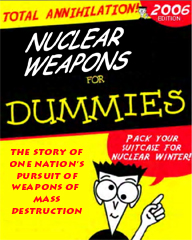Nuclear Weapons For Dummies
 Classified information suddenly has nowhere to hide. It's out on the web, unchaperoned by any net nanny. Now the nation-state has become just one more player in the marketplace of ideas.
Classified information suddenly has nowhere to hide. It's out on the web, unchaperoned by any net nanny. Now the nation-state has become just one more player in the marketplace of ideas.
The unimpeded flow of information, and its evil twin disinformation, comes with unforeseeable consequences. Imperfect security, indigestible lumps of data in the form of large electronic documents, compounded with the inherent perfect nature of the digital copy mean that there will be a continuing trickle of sensitive and accurate information bleeding out of all but the most well-bandaged regimes. Will those seeking perfect protection only serve to insure their own mummification?
Here is an example of a waveform representation of an audio file that has been sanitized by the US government:
In this case the excision of information was well done. I put it to test and there is no intelligible sound to be recovered from the official silence. But what about the image below? Does this tell us nothing about that old stand-by of the US nuclear arsenal, the B-61?
Don't ask me. I don't want one.
The examples of the Iranian and North Korean nuclear programs show that there remain prominent barriers to the creation of nuclear weapons. Metallurgy, precision machining, and acquisition of fissile materials all involve complex processes that take time and lots of money to master, even when the textbooks are at hand, even if you have blueprints from A.Q. Khan.
Nuclear weapons for dummies? Buy a suitcase nuke and don't waste your time on a nuclear program. After all, even if you are an army of one, you can still capitalize on all of the hard work done by big-budget governments.
Whether you're looking to hasten end-times, or simply to annihilate an enemy, this little baby will make the perfect traveling companion.



